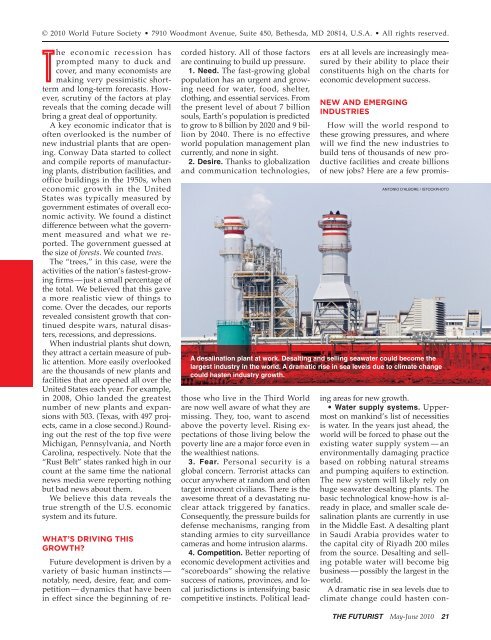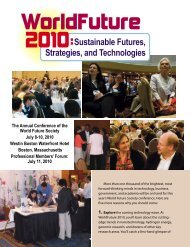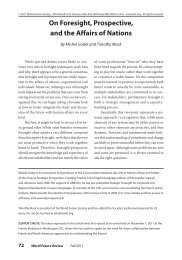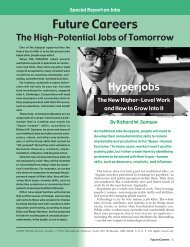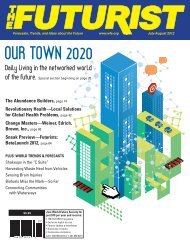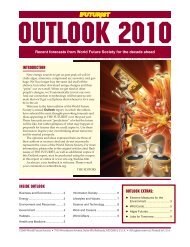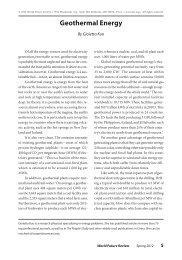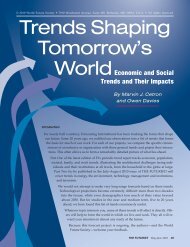BY MCKINLEY CONWAY - World Future Society
BY MCKINLEY CONWAY - World Future Society
BY MCKINLEY CONWAY - World Future Society
You also want an ePaper? Increase the reach of your titles
YUMPU automatically turns print PDFs into web optimized ePapers that Google loves.
© 2010 <strong>World</strong> <strong>Future</strong> <strong>Society</strong> • 7910 Woodmont Avenue, Suite 450, Bethesda, MD 20814, U.S.A. • All rights reserved.<br />
The economic recession has<br />
prompted many to duck and<br />
cover, and many economists are<br />
making very pessimistic shortterm<br />
and long-term forecasts. However,<br />
scrutiny of the factors at play<br />
reveals that the coming decade will<br />
bring a great deal of opportunity.<br />
A key economic indicator that is<br />
often overlooked is the number of<br />
new industrial plants that are opening.<br />
Conway Data started to collect<br />
and compile reports of manufacturing<br />
plants, distribution facilities, and<br />
office buildings in the 1950s, when<br />
economic growth in the United<br />
States was typically measured by<br />
government estimates of overall economic<br />
activity. We found a distinct<br />
difference between what the government<br />
measured and what we reported.<br />
The government guessed at<br />
the size of forests. We counted trees.<br />
The “trees,” in this case, were the<br />
activities of the nation’s fastest-growing<br />
firms — just a small percentage of<br />
the total. We believed that this gave<br />
a more realistic view of things to<br />
come. Over the decades, our reports<br />
revealed consistent growth that continued<br />
despite wars, natural disasters,<br />
recessions, and depressions.<br />
When industrial plants shut down,<br />
they attract a certain measure of public<br />
attention. More easily overlooked<br />
are the thousands of new plants and<br />
facilities that are opened all over the<br />
United States each year. For example,<br />
in 2008, Ohio landed the greatest<br />
number of new plants and expansions<br />
with 503. (Texas, with 497 projects,<br />
came in a close second.) Rounding<br />
out the rest of the top five were<br />
Michigan, Pennsylvania, and North<br />
Carolina, respectively. Note that the<br />
“Rust Belt” states ranked high in our<br />
count at the same time the national<br />
news media were reporting nothing<br />
but bad news about them.<br />
We believe this data reveals the<br />
true strength of the U.S. economic<br />
system and its future.<br />
WHAT’S DRIVING THIS<br />
GROWTH?<br />
<strong>Future</strong> development is driven by a<br />
variety of basic human instincts —<br />
notably, need, desire, fear, and competition<br />
— dynamics that have been<br />
in effect since the beginning of re-<br />
ing areas for new growth.<br />
• Water supply systems. Uppermost<br />
on mankind’s list of necessities<br />
is water. In the years just ahead, the<br />
world will be forced to phase out the<br />
existing water supply system — an<br />
environmentally damaging practice<br />
based on robbing natural streams<br />
and pumping aquifers to extinction.<br />
The new system will likely rely on<br />
huge seawater desalting plants. The<br />
basic technological know-how is already<br />
in place, and smaller scale desalination<br />
plants are currently in use<br />
in the Middle East. A desalting plant<br />
in Saudi Arabia provides water to<br />
the capital city of Riyadh 200 miles<br />
from the source. Desalting and selling<br />
potable water will become big<br />
business — possibly the largest in the<br />
world.<br />
A dramatic rise in sea levels due to<br />
climate change could hasten concorded<br />
history. All of those factors<br />
are continuing to build up pressure.<br />
1. Need. The fast-growing global<br />
population has an urgent and growing<br />
need for water, food, shelter,<br />
clothing, and essential services. From<br />
the present level of about 7 billion<br />
souls, Earth’s population is predicted<br />
to grow to 8 billion by 2020 and 9 billion<br />
by 2040. There is no effective<br />
world population management plan<br />
currently, and none in sight.<br />
2. Desire. Thanks to globalization<br />
and communication technologies,<br />
those who live in the Third <strong>World</strong><br />
are now well aware of what they are<br />
missing. They, too, want to ascend<br />
above the poverty level. Rising expectations<br />
of those living below the<br />
poverty line are a major force even in<br />
the wealthiest nations.<br />
3. Fear. Personal security is a<br />
global concern. Terrorist attacks can<br />
occur anywhere at random and often<br />
target innocent civilians. There is the<br />
awesome threat of a devastating nuclear<br />
attack triggered by fanatics.<br />
Consequently, the pressure builds for<br />
defense mechanisms, ranging from<br />
standing armies to city surveillance<br />
cameras and home intrusion alarms.<br />
4. Competition. Better reporting of<br />
economic development activities and<br />
“scoreboards” showing the relative<br />
success of nations, provinces, and local<br />
jurisdictions is intensifying basic<br />
competitive instincts. Political lead-<br />
ers at all levels are increasingly measured<br />
by their ability to place their<br />
constituents high on the charts for<br />
economic development success.<br />
NEW AND EMERGING<br />
INDUSTRIES<br />
ANTONIO D’ALBORE / ISTOCKPHOTO<br />
A desalination plant at work. Desalting and selling seawater could become the<br />
largest industry in the world. A dramatic rise in sea levels due to climate change<br />
could hasten industry growth.<br />
How will the world respond to<br />
these growing pressures, and where<br />
will we find the new industries to<br />
build tens of thousands of new productive<br />
facilities and create billions<br />
of new jobs? Here are a few promis-<br />
THE FUTURIST May-June 2010 21


